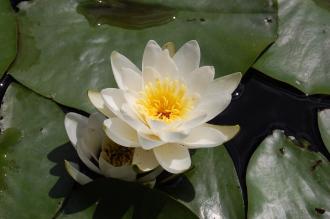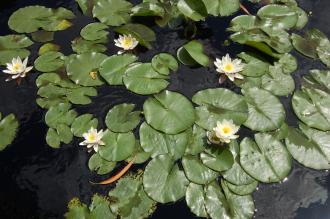
Nymphaea candida Flower (30/06/2012, kew Gardens, London)
Position: Full sun
Flowering period: Summer
Soil: Wet (planting depth 10cm – 40m)
Eventual Height: 10cm (above water)
Eventual Spread: 1.2m
Hardiness: 4a – 9a
Family: Nymphaeaceae
Nymphaea candida is a deciduous, aquatic, perennial plant. Its dark green leaves are suborbicular with a ‘V’ notch, smooth with a waxy coating, up to 25cm across and float. Its white flowers have yellow stamen, numerous white petals with rounded, pointed tips, are up to 20cm across, rise on solitary stalks, float and are self pollinating Its roots are rhizomes.
Nymphaea candida, commonly known as Water Lilly, is native to much of Europe (not the UK) and south west Asia.
The etymological root of the binomial name Nymphaea is derived from Greek mythology where nymphs were minor deities associated with specific locations, including springs or small bodies of water. Candida is from the Latin meaning ‘bright’ or ‘pure’, in reference to the flower.

Nymphaea candida (30/06/2012, kew Gardens, London)
The landscape architect may find Nymphaea candida useful as an aquatic plant in lakes and ponds.
Ecologically, N. candida is pollinated by flies and beetles.
N. candida prefers wet soils, with a planting depth in water of 10cm to 40cm. It tolerates most pH of soil.
Nymphaea candida requires little maintenance. Large clumps may be divided in summer.

